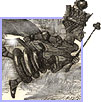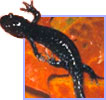Ensaio: As vantagens da Reprodução Sexual, por Matt Ridley (Inglês)
  | ||||||||||||
 | ||||||||||||
| ||||||||||||
 | ||||||||||||
| ||||||||||||
 | ||||||||||||
 Mutations can result from one change in one nucleotide of 6 billion in a human cell. | Can sex earn its keep? | |
| But why eliminate mutations in this way, rather than correcting more of them by better proofreading? Kondrashov has an ingenious explanation of why this makes sense: It may be cheaper to allow some mistakes through and remove them later. The cost of perfecting proofreading mechanisms escalates as you near perfection. According to Kondrashov's calculations, the rate of deleterious mutations must exceed one per individual per generation if sex is to earn its keep eliminating them; if less than one, then his idea is in trouble. The evidence so far is that the deleterious mutation rate teeters on the edge: it is about one per individual per generation in most creatures. But even if the rate is high enough, all that proves is that sex can perhaps play a role in purging mutations. It does not explain why sex persists. | ||
 |  Strawberries reproduce asexually by vegetative propagation -- sending out runners. | |
| The main defect in Kondrashov's hypothesis is that it works too slowly. Pitted against a clone of asexual individuals, a sexual population must inevitably be driven extinct by the clone's greater productivity, unless the clone's genetic drawbacks can appear in time. Currently, a great deal of effort is going into the testing of this model by measuring the deleterious mutation rate, in a range of organisms from yeast to mouse. But the answer is still not entirely clear. |

 The Red Queen is a metaphor for evolutionary change. | Enter the Red Queen | |
| In the late 1980s the Red Queen hypothesis emerged, and it has been steadily gaining popularity. First coined by Leigh Van Valen of the University of Chicago, it refers to Lewis Carroll's Through the Looking Glass, in which the Red Queen tells Alice, "[I]t takes all the running you can do, to keep in the same place." This never-ending evolutionary cycle describes many natural interactions between hosts and disease, or between predators and prey: As species that live at each other's expense coevolve, they are engaged in a constant evolutionary struggle for a survival advantage. They need "all the running they can do" because the landscape around them is constantly changing. | ||
 | ||
| The Red Queen hypothesis for sex is simple: Sex is needed to fight disease. Diseases specialize in breaking into cells, either to eat them, as fungi and bacteria do, or, like viruses, to subvert their genetic machinery for the purpose of making new viruses. To do that they use protein molecules that bind to other molecules on cell surfaces. The arms races between parasites and their hosts are all about these binding proteins. Parasites invent new keys; hosts change the locks. For if one lock is common in one generation, the key that fits it will spread like wildfire. So you can be sure that it is the very lock not to have a few generations later. According to the Red Queen hypothesis, sexual reproduction persists because it enables host species to evolve new genetic defenses against parasites that attempt to live off them. |  Immune cells have receptors (locks) for binding proteins (keys) of viruses such as HIV, that allow them to dock and gain entry. |
|
| Keeping variety in store | |
| Sexual species can call on a "library" of locks unavailable to asexual species. This library is defined by two terms: heterozygosity, when an organism carries two different forms of a gene, and polymorphism, when a population contains multiple forms of a gene. Both are lost when a lineage becomes inbred. What is the function of heterozygosity? In the case of sickle cell anemia, the sickle gene helps to defeat malaria. So where malaria is common, the heterozygotes (those with one normal gene and one sickle gene) are better off than the homozygotes (those with a pair of normal genes or sickle genes) who will suffer from malaria or anemia. | ||
 | ||
| One of the main proponents of the Red Queen hypothesis was the late W. D. Hamilton. In the late 1970s, with the help of two colleagues from the University of Michigan, Hamilton built a computer model of sex and disease, a slice of artificial life. It began with an imaginary population of 200 creatures, some sexual and some asexual. Death was random. As expected, the sexual race quickly died out. In a game between sex and "asex," asex always wins -- other things being equal. That's because asexual reproduction is easier, and it's guaranteed to pass genes on to one's offspring. |  Sea anemones reproduce asexually. | |

|
| Adding parasites to the mix | |
| Next they introduced several species of parasite, 200 of each, whose power depended on "virulence genes" matched by "resistance genes" in the hosts. The least resistant hosts and the least virulent parasites were killed in each generation. Now the asexual population no longer had an automatic advantage -- sex often won the game. It won most often if there were lots of genes that determined resistance and virulence in each creature. | ||
 | ||
| In the model, as resistance genes that worked would become more common, then so too would the virulence genes. Then those resistance genes would grow rare again, followed by the virulence genes. As Hamilton put it, "antiparasite adaptations are in constant obsolescence." But in contrast to asexual species, the sexual species retain unfavored genes for future use. "The essence of sex in our theory," wrote Hamilton, "is that it stores genes that are currently bad but have promise for reuse. It continually tries them in combination, waiting for the time when the focus of disadvantage has moved elsewhere." |  Sexual species have variety on their side. |

|
| Real-world evidence | |
| In the years since Hamilton's simulations, empirical support for his hypothesis has been growing. There is, first, the fact that asexuality is more common in species that are little troubled by disease: boom-and-bust microscopic creatures, arctic or high-altitude plants and insects. The best test of the Red Queen hypothesis, though, was a study by Curtis Lively and Robert Vrijenhoek, then of Rutgers University in New Jersey, of a little fish in Mexico called the topminnow. The topminnow, which sometimes crossbreeds with another similar fish to produce an asexual hybrid, is under constant attack by a parasite, a worm that causes "black-spot disease." The researchers found that the asexually reproducing topminnows harbored many more black-spot worms than did those producing sexually. That fit the Red Queen hypothesis: The sexual topminnows could devise new defenses faster by recombination than the asexually producing ones. | ||
 | ||
It could well be that the deleterious mutation hypothesis and the Red Queen hypothesis are both true, and that sex serves both functions. Or that the deleterious mutation hypothesis may be true for long-lived things like mammals and trees, but not for short-lived things like insects, in which case there might well be need for both models to explain the whole pattern. Perpetually transient, life is a treadmill, not a ladder.  |
[via Evolution Society]

- Symphony Of Science - 'the Unbroken Thread' (ft. Attenborough, Goodall, Sagan)
[David Attenborough] All life is related And it enables us to construct with confidence The complex tree that represents the history of life Our planet, the Earth, is as far as we know Unique in the universe; it contains life Here plants and animals...
- Vírus Do Borna Entra No Genoma De Muitos Mamíferos, Incluindo Genoma Humano
ScienceDaily (Jan. 8, 2010) About eight percent of human genetic material comes from a virus and not from our ancestors, according to researchers in Japan and the U.S. The study, and an accompanying News & Views article by University...
- Cromossomas Y Dos Chimpanzés E Dos Humanos São Muito Divergentes Na Estrutura E No Conteúdo Genético
10 NAT Chimpanzee and Human Y Chromosomes.. Divergent. O cromossoma Y humano começou a evoluir de um autossoma há centenas de milhões de anos atrás, adquirindo a função de determinação sexual e submetido a uma série de inversões que...
- Alguns Animais Nasceram Selvagens E Outros Não
Scientists have Identified Genetic Regions Linked to Tameness by Denise ChenJune 24, 2009 [posted here] There are lots of differences between wild and domestic animals. Consider a wolf versus a dog, or a lion versus a cat. Aside from changes to make...
- Como Evoluiu A Vagina?
Do mesmo autor da postagem anterior PZ Myers Resumo do artigo Em praticamente todos os seres vivos, à excepção dos Mamíferos, o sistema reprodutor combinado com o sistema digestivo e urinário, desembocam todos num único tubo com contacto para o...








